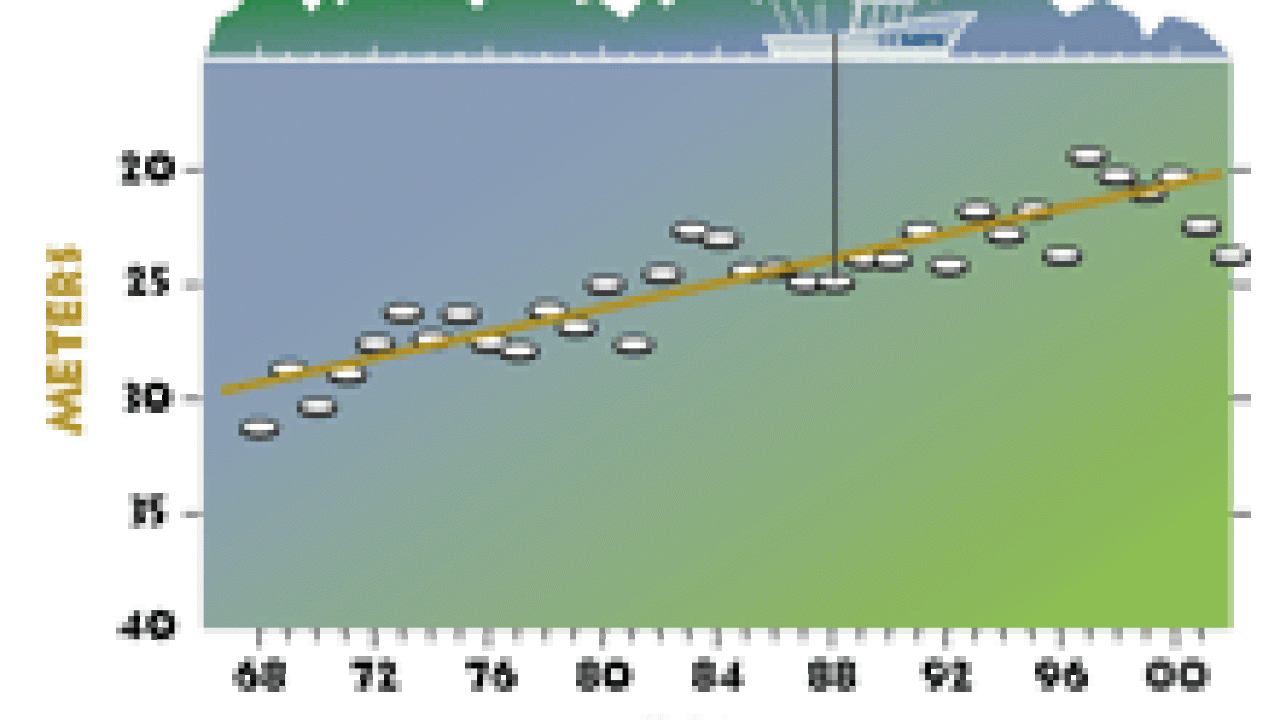In 2002, Lake Tahoe was the clearest it had been in 10 years, said UC Davis researchers today. The UC Davis Tahoe Research Group, which has worked with Tahoe policy-makers for more than 40 years, said the new finding could mean that science-based recovery projects in the region are making a difference.
"These are encouraging results, and we hope they indicate the beginning of the lake's recovery," said Charles Goldman, director and founder of the Tahoe Research Group.
"However, 10 years is a short time and it is too early to say if the recent improvements will continue. "We must keep up our efforts to prevent water and air pollution, or we may still end up with a green lake."
UC Davis researchers measure the lake's clarity every seven to 10 days by lowering a white, dinner-plate-sized disk (called a Secchi disk) into the water at fixed locations and noting the depth at which the disk disappears from sight.
The new data show that in 2002 Lake Tahoe clarity reached an annual average of 78 feet. It has not been that clear since 1992, when it reached 78.3 feet. This remains a far cry from 1968, when Secchi measurements began; at that time, the disk could be seen at an average depth of 102.4 feet.
Last year, lake advocates were heartened by the finding that clarity had reached a five-year high; the disk could be seen to a depth of 73.6 feet.
The UC Davis Tahoe Research Group's data are routinely used by the Tahoe Regional Planning Agency, which leads the program to restore the health of the Tahoe Basin ecosystem. The cornerstone of the agency's restoration activities is its Environmental Improvement Program, a large group of projects designed to achieve and maintain healthy natural resources.
Many of the TRPA's environmental improvement projects aim to improve lake clarity by reducing the runoff of fine sediment, which makes the water cloudy; the runoff of nutrients (such as fertilizers) that promote algae growth, which makes the water green; and the depositing of air pollution into the lake.
Goldman said those restoration activities as well as others may well have contributed to the improvement seen in 2002. He also noted that 2001 and 2002 were drier than average, which reduced runoff and could have helped clarity.
"Whether or not runoff was reduced by low precipitation or by improvement projects, or both, the lake may be showing that it can recover," Goldman said.
Added TRPA executive director Juan Palma, "We were also pleased to see a significant decrease in algae growth last year. These positive numbers should motivate us to continue our strategy of investing in soil-erosion control, storm-water treatment and transportation alternatives.
"While we can't explain with great certainty what the latest data are telling us right now, we are confident that important research currently under way at Lake Tahoe will help us answer these important questions."
Current research projects that are relevant to water clarity include a stream-loading study, a storm-water runoff study, an analysis of atmospheric pollutants and a study of turbidity along the shoreline.
The UC Davis Tahoe Research Group works on scientific problems in the basin in collaboration with local, state and federal agencies and the private sector. Research partners include the University of Nevada at Reno, Desert Research Institute, Tahoe Regional Planning Agency, Lahontan Regional Water Quality Control Board, California EPA, California Air Resources Board, Nevada Department of Environmental Protection, U.S. Environmental Protection Agency, U.S. Forest Service, and U.S. Geological Survey.
Between now and 2007, several major Tahoe Basin agencies will produce important updates of their environmental and management plans that will guide policy-making and development in the basin through 2027. In the largest Tahoe research effort yet ($6 million), more than 100 scientists will provide information to help policy-makers write the plans.
One essential component of the plans will be the development of a new water-pollution standard known as the Lake Tahoe Total Maximum Daily Load (TMDL). The pollution-load scientific work is being done by many of UC Davis' research partners; it is coordinated by UC Davis Tahoe Research Group watershed scientist John Reuter.
Reuter said that the goal of the pollution-load research is to determine what levels of pollutant reduction are necessary; the goal of the TRPA Environmental Improvement Program is to be a blueprint for how to achieve this reduction.
"The continued improvement in lake clarity in 2002 provides strong evidence that, if pollutant loading can be reduced by a sufficient magnitude, we could see an improvement in lake conditions within a decade," he said.
In other recent events, Charles Goldman was just awarded the Nevada Medal by the Desert Research Institute, in recognition of his outstanding achievements in science. He will be honored at ceremonies in Las Vegas and Reno in March by the Nevada governor and legislature.
"The value of our long-term Tahoe data can scarcely be overemphasized," Goldman said today. "This ongoing study, which began in 1959, enables us to realistically evaluate changes in the lake that are influenced by a multitude of physical, chemical, biological and meteorological processes."
Also, UC Davis continues working toward construction of a new $13.2 million research facility and education center, the Lake Tahoe Center for Environmental Research and Education. The Tahoe Regional Planning Agency governing board will hear an update on those plans at its meeting this Wednesday, Feb. 26.
For more information:
- Tahoe Research Group projects are described at http://trg.ucdavis.edu/.
- The Tahoe Regional Planning Agency's Environmental Improvement Program is described at http://www.trpa.org/.
- The Lake Tahoe Center for Environmental Research and Education is described at http://www.ormp.ucdavis.edu/environreview/tahoe.html.
Media Resources
Charles Goldman, Tahoe Research Group, (530) 752-1557, crgoldman@ucdavis.edu
John Reuter, Tahoe Research Group, (530) 304-1473, jereuter@ucdavis.edu
Juan Palma, Tahoe Regional Planning Agency, (775) 588-4547
